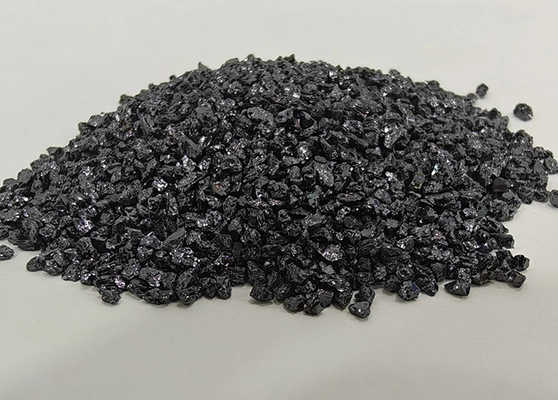Quick Answer: Silicon carbide powder (SiC) is a high-hardness, high-thermal-conductivity abrasive and ceramic feedstock supplied mainly as black SiC (tough, economical) and green SiC (higher purity, sharper). It’s used in grinding/polishing, blasting, refractories, engineering ceramics, metallurgy, and—at very high purities—electronics. Common grit sizes in this guide include 60, 80, 120, 220, 600, and 1500, each matched to specific cutting rates and finish requirements.
What Is Silicon Carbide Powder?
Silicon carbide powder is produced by high-temperature fusion of silica and carbon (Acheson-type process), followed by crushing, milling, purification (water-wash/acid-wash), and classification into standardized particle-size distributions (FEPA/JIS/ANSI). The grains are angular, sharp, and friable, enabling rapid stock removal and self-sharpening during grinding or blasting. Beyond abrasives, specific grades serve as refractory aggregates, ceramic feedstock, and—in ultra-high purities—semiconductor materials.
- Hardness: Mohs ~9.2–9.5 (near diamond)
- Thermal conductivity: High compared with most ceramics
- Chemical stability: Generally inert to many acids/alkalis; forms protective SiO₂ layer in oxidizing high-T environments
- Density: ~3.2 g/cm³ (material-dependent)
Types: Black vs Green Silicon Carbide Powder
Black Silicon Carbide Powder
- Typical purity: ~95–98% SiC
- Traits: Tough, economical; suitable for blasting, heavy stock removal, general grinding
- Common uses: Sandblasting media, bonded/coated abrasives, refractory aggregates
Green Silicon Carbide Powder
- Typical purity: ≥99% SiC
- Traits: Higher purity and sharper fracture; ideal for precision finishing and microgrit polishing
- Common uses: Fine grinding/lapping of glass and ceramics, precision polishing, high-end ceramic components
Rule of thumb: Choose black SiC for cost-effective cutting and blasting; choose green SiC for high-purity, high-finish applications.
Silicon Carbide Powder Uses
- Abrasives: Grinding wheels, stones, sandpapers/belts, lapping and polishing slurries
- Blasting media: Surface preparation (rust/scale/paint removal), profile generation for coating adhesion
- Refractories: Bricks, castables, kiln furniture—benefiting from thermal shock resistance and conductivity
- Engineering ceramics: Seals, bearings, nozzles—wear- and corrosion-resistant components
- Metallurgy: Deoxidizer/additive in steelmaking and foundry
- Semiconductors (specialty grades): Ultra-high purity SiC powders for wafer/device value chains
Grit Sizes Explained (60–1500)
Grit numbers represent particle-size ranges under specific standards. Coarser grits (lower numbers) remove material quickly and produce rougher profiles; finer grits (higher numbers) deliver smoother finishes. Below are practical summaries for the six spotlight grits in this guide. Values are indicative—always verify with FEPA/JIS specs and supplier COA.
| Grit | Indicative Median Size (μm) | Cut Rate | Typical Finish | Common Applications |
|---|---|---|---|---|
| 60 | ~250–300 | Very high | Coarse | Aggressive grinding, heavy blasting, initial shaping |
| 80 | ~180–220 | High | Medium-coarse | General grinding, surface prep, pre-finish blasting |
| 120 | ~120–140 | Moderate | Medium | Intermediate smoothing, between coarse cut and fine finish |
| 220 | ~60–70 | Moderate–low | Fine | Pre-polish steps, finer blasting profiles, coated abrasives |
| 600 | ~20–30 | Low | Very fine | Lapping/polishing transitions, precision finishing |
| 1500 | ~10–14 (microgrit) | Very low | Near-polish | Final polishing on ceramics/glass; micro-finishing |
60 Grit Silicon Carbide Powder
Best for: Roughing and fast stock removal. Suitable for heavy-duty blasting on steel, rapid beveling of stone/ceramics, and initial steps in lapidary. Works well as black SiC where cost and throughput matter.
80 Grit Silicon Carbide Powder
Best for: General-purpose grinding and blasting. Balances speed and control; common in surface preparation before coating or further sanding.
120 Grit Silicon Carbide Powder
Best for: Intermediate smoothing. Often used after 80 grit to refine scratches while retaining adequate removal rate; a staple in coated abrasives.
220 Grit Silicon Carbide Powder
Best for: Pre-polish stages and finer blasting profiles; frequently chosen in green SiC for glass/ceramic pre-finish steps.
600 Grit Silicon Carbide Powder
Best for: Fine lapping and polishing transitions. Common in precision finishing workflows (optics/ceramics) where consistent PSD and high purity matter.
1500 Grit Silicon Carbide Powder
Best for: Near-final polish and micro-finishing. Typically green SiC microgrits for highly controlled, ultra-smooth surfaces.
How to Choose: Type, Grit & Specs
- Define the process goal: Rough removal vs fine finish vs polish.
- Select the type: Black SiC for economical cutting; Green SiC for high-purity, fine finishing.
- Pick the grit band:
- 60–80: aggressive removal
- 120–220: mid-to-fine finishing/pre-polish
- 600–1500: fine lapping and polishing
- Specify the standard: FEPA/JIS/ANSI grit numbers; ask for sieve curves or D10/D50/D90.
- Quality data: Request COA (purity, PSD, magnetic ppm, moisture/LOI; note washing method).
- Bond/process fit: Ensure compatibility with binders (for wheels/coatings) or slurry chemistry (for lapping/polishing).
- Trial & iterate: Run small-scale trials to lock the optimal grit and process parameters.
Price Notes & Supply Considerations
- Type/purity: Black SiC powders are generally cheaper than green SiC; microgrits cost more than macrogrits.
- Washing & cleanliness: Acid-wash/water-wash add cost but reduce impurities and magnetic content.
- Region/logistics: FOB vs CIF can shift landed cost; plan for freight, duties, and lead times.
- Volume tiers: Bulk buys lower per-ton cost; long-term contracts stabilize supply for critical grades.
For an indicative overview, see our dedicated article: Silicon Carbide Powder Price: Factors & Trends.
FAQs
Black vs green silicon carbide powder—how do I choose?
Use black for economical grinding/blasting and green for high-purity, fine-finishing tasks. Let application tolerance and finish requirements guide the decision.
Is 220 grit fine enough for pre-polish?
Yes. 220 grit is a common pre-polish step before moving to 600+ for fine lapping or polishing.
Can I mix grits to save cost?
Mixing grits often leads to inconsistent finishes. It’s better to step through defined grit stages (e.g., 80 → 120 → 220 → 600).
What documents should I request from suppliers?
A lot-specific COA including PSD (sieve curve or D10/D50/D90), %SiC purity, magnetic ppm, moisture/LOI, and washing method.
References
- FEPA & JIS grit size frameworks and supplier COA practices
- Materials engineering handbooks covering SiC properties and applications
- Industrial application notes on blasting profiles, grinding/lapping workflows, and refractory/ceramic formulations
